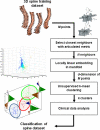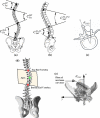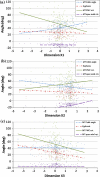Classification of three-dimensional thoracic deformities in adolescent idiopathic scoliosis from a multivariate analysis
- PMID: 21879413
- PMCID: PMC3252447
- DOI: 10.1007/s00586-011-2004-2
Classification of three-dimensional thoracic deformities in adolescent idiopathic scoliosis from a multivariate analysis
Abstract
Purpose: Understanding how to classify and quantify three-dimensional (3D) spinal deformities remains an open question in adolescent idiopathic scoliosis. The objective of this study was to perform a 3D manifold characterization of scoliotic spines demonstrating thoracic deformations using a novel geometric and intuitive statistical tool to determine patterns in pathological cases.
Methods: Personalized 3D reconstructions of thoracic (T)/lumbar (L) spines from a cohort of 170 Lenke Type-1 patients were analyzed with a non-linear manifold embedding algorithm in order to reduce the high-dimensionality of the data, using statistical properties of neighbouring spine models. We extracted sub-groups of the data from the underlying manifold structure using an unsupervised clustering algorithm to understand the inherent distribution and determine classes of pathologies which appear from the low-dimensional space.
Results: For Lenke Type-1 patients, four clusters were detected from the low-dimensional manifold of 3D models: (1) normal kyphosis (T) with hyper-lordosis (L) and high Cobb angles (37 cases), (2) low kyphosis (T) and normal lordosis (L), with high rotation of plane of maximum curvature (55 cases), (3) hypo-kyphotic (T) and hyper-lordosis (L) (21 cases) and (4) hyper-kyphotic (T) with strong vertebral rotation (57 cases). Results show the manifold representation can potentially be useful for classification of 3D spinal pathologies such as idiopathic scoliosis and serve as a tool for understanding the progression of deformities in longitudinal studies.
Conclusions: Quantitative evaluation illustrates that the complex space of spine variability can be modeled by a low-dimensional manifold and shows the existence of an additional hyper-kyphotic subgroup from the cohort of 3D spine reconstructions of Lenke Type-1 patients when compared with previous findings on the 3D classification of spinal deformities.
Figures








References
-
- Villemure I, Aubin CE, Grimard G et al. (2001) Progression of vertebral and spinal three-dimensional deformities in adolescent idiopathic scoliosis: a longitudinal study. Spine 2226–2244 - PubMed
MeSH terms
LinkOut - more resources
Full Text Sources
Other Literature Sources
Medical

